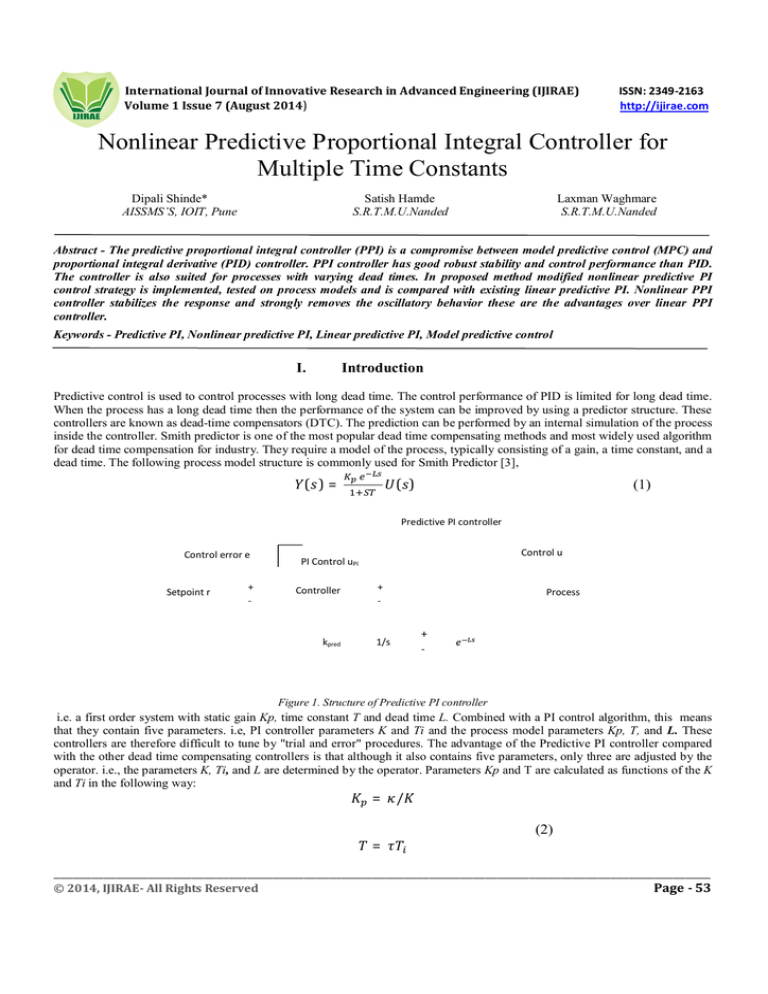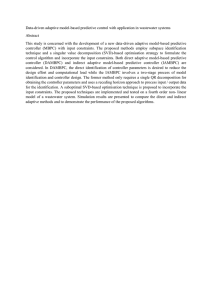
International Journal of Innovative Research in Advanced Engineering (IJIRAE)
Volume 1 Issue 7 (August 2014)
ISSN: 2349-2163
http://ijirae.com
Nonlinear Predictive Proportional Integral Controller for
Multiple Time Constants
Dipali Shinde*
AISSMS’S, IOIT, Pune
Satish Hamde
S.R.T.M.U.Nanded
Laxman Waghmare
S.R.T.M.U.Nanded
Abstract - The predictive proportional integral controller (PPI) is a compromise between model predictive control (MPC) and
proportional integral derivative (PID) controller. PPI controller has good robust stability and control performance than PID.
The controller is also suited for processes with varying dead times. In proposed method modified nonlinear predictive PI
control strategy is implemented, tested on process models and is compared with existing linear predictive PI. Nonlinear PPI
controller stabilizes the response and strongly removes the oscillatory behavior these are the advantages over linear PPI
controller.
Keywords - Predictive PI, Nonlinear predictive PI, Linear predictive PI, Model predictive control
I.
Introduction
Predictive control is used to control processes with long dead time. The control performance of PID is limited for long dead time.
When the process has a long dead time then the performance of the system can be improved by using a predictor structure. These
controllers are known as dead-time compensators (DTC). The prediction can be performed by an internal simulation of the process
inside the controller. Smith predictor is one of the most popular dead time compensating methods and most widely used algorithm
for dead time compensation for industry. They require a model of the process, typically consisting of a gain, a time constant, and a
dead time. The following process model structure is commonly used for Smith Predictor [3],
( )=
( )
(1)
Predictive PI controller
Control error e
Setpoint r
+
-
Control u
PI Control uPI
Controller
kpred
+
-
1/s
Process
+
-
Figure 1. Structure of Predictive PI controller
i.e. a first order system with static gain Kp, time constant T and dead time L. Combined with a PI control algorithm, this means
that they contain five parameters. i.e, PI controller parameters K and Ti and the process model parameters Kp, T, and L. These
controllers are therefore difficult to tune by "trial and error" procedures. The advantage of the Predictive PI controller compared
with the other dead time compensating controllers is that although it also contains five parameters, only three are adjusted by the
operator. i.e., the parameters K, Ti, and L are determined by the operator. Parameters Kp and T are calculated as functions of the K
and Ti in the following way:
= /
(2)
=
_________________________________________________________________________________________________________
© 2014, IJIRAE- All Rights Reserved
Page - 53
International Journal of Innovative Research in Advanced Engineering (IJIRAE)
Volume 1 Issue 7 (August 2014)
ISSN: 2349-2163
http://ijirae.com
Where, κ and τ are constants
The predictive controller can be expressed as,
( )=
=
1+
1+
( )−
1
( )−
(
)
(
)
1+
[ ( ) − ( − )]
[ ( ) − ( − )]
(3)
where p is the differential operator d/dt.
The open loop system has a pole at s= -1/T. With PI control the closed loop system is of second order. The design criterion is
chosen so that the closed loop system has a double pole at s= -1/T. This gives the following values of κ and τ
=1
=1
(4)
Equation (3) is simplified as,
( )=
1+
( )−
[ ( ) − ( − )]
(5)
PPI controller has good robust stability and control performance than PID. The controller is also suited for processes with varying
dead times. [3]
As shown in Fig.1, industrial processes generally are complex, containing interacting MIMO controller loops. It is required to
select appropriate pairing of the input and output variables to ensure more effective control. There are different decoupling
techniques. Predictive control for MIMO processes ensures inherent decoupling if the cost function does not include terms
punishing the control increments. But these terms are used to keep the control variables within their limit values. Enhancing
decoupling properties of predictive control algorithms is important for practical applications [6,11]. Most of the plants contain
nonlinearities. The control algorithms generally consider linear or linearised models around the working points. Predictive control
algorithms based on nonlinear model of the plant show the better performance in the whole operating range than linear models.
II.
A.
PROPOSED NONLINEAR PREDICTIVE PI CONTROLLER
S TRUCTURE OF NONLINEAR PREDICTIVE PI CONTROLLER
Figure 2. Nonlinear predictive PI controller structure
_________________________________________________________________________________________________________
© 2014, IJIRAE- All Rights Reserved
Page - 54
International Journal of Innovative Research in Advanced Engineering (IJIRAE)
Volume 1 Issue 7 (August 2014)
ISSN: 2349-2163
http://ijirae.com
B. DESIGN OF NONLINEAR PREDICTIVE PI CONTROLLER
Let GP and GC be the transfer functions of the process and the controller. The closed-loop transfer function obtained with error
feedback is then
G O=
GP GC
.
1+GP GC
(6)
Solving this equation for Gc we get
G =
.
.
(7)
If the closed-loop transfer function Go is specified and Gp is known, it is thus easy to compute Gc.
Consider a process with the transfer function
G =
e
.
(8)
Assume that the desired closed-loop transfer function is specified as
G =
.
(9)
Where λ is a tuning parameter. The time constants of the open- and closed-loop systems are the same when λ = 1. The closed-loop
system responds faster than the open-loop system if λ < 1. It is slower when λ > 1.
It follows from Equation (2) that the controller transfer function becomes
G = (
.
(10)
)
The controller has integral action, because GC (0) = ∞. The input output relation of the controller is,
(1 − e )U(s) .
U(s) =
1+
E(s) −
(11)
The PPI controller can be written as,
(1 − e
U(s) =
1+
E(s) −
Linear PI controller with gain K =
)U(s)
(12)
and integral time Ti = T.
Controller equation in time domain
u ( ) = K e( ) +
∫ e( ) dt −
∫ (1 − e
)u(t)dt
(13)
Here, Linear PI controller is replaced by nonlinear PI controller
u ( ) = K (1 + β e( ) )e( ) +
∫ e( ) dt −
∫ (1 − e
)u(t)dt
(14)
C. SIMULATION RESULTS
Simulation has been done for following processes for comparison between linear predictive PI and proposed nonlinear predictive
PI controller. Processes are,
Example (1)
.
( )
=
( )
=
2 +5
Example (2)
+6 +2
( + 1)(0.5 + 1)(0.25 + 1)(0.125 + 1)
Example
( )
=
(3)
+ 10
10
+ 35
+ 50 + 24
_________________________________________________________________________________________________________
© 2014, IJIRAE- All Rights Reserved
Page - 55
International Journal of Innovative Research in Advanced Engineering (IJIRAE)
Volume 1 Issue 7 (August 2014)
ISSN: 2349-2163
http://ijirae.com
In figures 3 to 5 responses are controlled by predictive PI controller (12) and nonlinear predictive PI controller (14) are presented.
From these figures it shows that nonlinear PPI controller proposed (14) in this paper gives shorter settling time, smaller overshoot
and smaller rise time in comparison to predictive PI controller.
Figure 3. Comparison between linear and nonlinear predictive PI control (Example 1)
Figure 4. Comparison between linear and nonlinear predictive PI control (Example 2)
_________________________________________________________________________________________________________
© 2014, IJIRAE- All Rights Reserved
Page - 56
International Journal of Innovative Research in Advanced Engineering (IJIRAE)
Volume 1 Issue 7 (August 2014)
ISSN: 2349-2163
http://ijirae.com
Figure 5. Comparison between linear and nonlinear predictive PI control (Example 3)
CONCLUSION
In this paper nonlinear predictive PI control (14) strategy is implemented, tested on process models and is compared with linear
predictive PI (12). It can be concluded that proposed nonlinear PPI controller has good robust stability and control performance
than PPI controller. This controller is also suited for processes with varying dead times. Simulated results show excellent tracking
performance than linear PPI controllers with minimum reaching time and less oscillation.
REFERENCES
Julio E.Normey-Rico, Ismael Alcalla, Juan Glomez Ortega, Eduardo F. Camacho, “Mobile robot path tracking using a robust
PID controller”, Control Engineering Practice, vol. 9, pp. 1209-1214,2001.
[2] Pasi Airikka, “Extended predictive proportional Integral controller for typical industrial processes”, The 18th IFAC World
Congress, Milan,Italy,2011.
[3] Zhengyun Rent Hong Zhang & Huihe Shao, “Comparison of PID Control and PPI Control”, 42 nd IEEE Conference on
Decision and Control, Maui, Hawaii USA, December 2003.
[4] T. Hagglund, “An Industrial Dead-Time compensating PI controller”, Pergamon, Elsevier Science Ltd, Vol. 4, No. 6, 749756,1996.
[5] T. Hagglund and K. J. Astrom, “PID Controllers: Theory, Design and Tuning”, Instrument Society of America, 2 nd
Edition.156-164,1995.
[6] Julio E. Normey-Rico & Eduardo. F. Camacho, “Dead-time compensators: A survey”. Control Engineering Practice 16
(2008) 407–428,2008.
[7] Ari Ingimundarson & Tore Hagglund.“Robust tuning procedures of dead-time compensating controllers”. Control
Engineering Practice 9, 1195–1208, 2001.
[8] W.L. Lo, A.B. Rad & K.M. Tsang.“Auto-tuning of output predictive PI controller”, ISA Transactions 38, 25- 36, 1999.
[9] Aleksandar I. Ribic & Miroslav R. Matausek. “A New Predictive PI Controller with Additonal Filtering”.IFAC Conference
on Advances in PID Control Brescia (Italy), March 2012.
[10] Tore Hagglund, “A Predictive PI Controller for Processes with Long Dead Times”. IEEE control systems.57-60, February
1992.
[11] Qin S.J., Badgwell T. A. “An overview of industrial model predictive control technology”. Chemical process control—CPC
V,CACH E. Tahoe City, CA, January 1996.
[1]
_________________________________________________________________________________________________________
© 2014, IJIRAE- All Rights Reserved
Page - 57
International Journal of Innovative Research in Advanced Engineering (IJIRAE)
Volume 1 Issue 7 (August 2014)
ISSN: 2349-2163
http://ijirae.com
[12] Robert Haber, Ruth Bars and Ulrich Schmitz, “Predictive Control in Process Engineering”, First Edition.WILEY-VCHVerlag
GmbH & Co. KGaA, 2011.
[13] Arousi F., Bars R., Haber R. “Optimization of PI controller for a predicted cost function assuming a first-order process with
dead time”, 13th IFAC Workshop on Control Applications of Optimisation, Paris-Cachan, France, (2006).
[14] Raymond A. Wright “Model-Based Synthesis of Nonlinear PI and PID Controllers”, AIChE Journal, 2001 Vol. 47, No. 8,
pg. 1805.
[15] Astrom, K. J., and B. Wittenmark, Computer-Controlled Systems, Theory and Design, Prentice Hall, Englewood Cliffs,
NJ(1990).
[16] Balasubramhanya, L. S., and F. J. Doyle, ‘‘Low Order Modeling for Nonlinear Process Control,’’ Proc 1995 Amer. Control
Conf., Seattle, WA(1995).
[17] Bequette, B. W., ‘‘Nonlinear Control of Chemical Processes: A Review,’’ Ind. Eng. Chem, Res., 30, 1391 (1991).
[18] Cheung, T. F., and W. L. Luyben, ‘‘Nonlinear and Nonconventional Liquid Level Controllers,’’ Ind. Eng. Chem. Fundam.,
19, 93(1980).
[19] Daoutidis, P., and C. Kravaris, ‘‘Dynamic Output Feedback Control of Minimum-Phase Nonlinear Processes,’’ Chem. Eng.
Sci., 47, 837, 1992.
[20] Fogler, H. S., “Elements of Chemical Reaction Engineering”, Prentice Hall, Englewood Cliffs, NJ (1992).
[21] Isidori A., “Nonlinear Control Systems: An Introduction”, Springer, Berlin, 1989.
[22] Isidori A. and A. Ruberti, ‘‘On the Synthesis of Linear Input-Output Responses for Nonlinear Systems,’’ Syst. Control Lett.,
4, 17, 1984..
[23] Jutan, ‘‘A Nonlinear PI&D. Controller,’’ Can. J. Chem. Eng., 67, 485,1989..
[24] Kailath T., “Linear Systems”, Prentice Hall, Englewood Cliffs, NJ, 1980.
_________________________________________________________________________________________________________
© 2014, IJIRAE- All Rights Reserved
Page - 58



